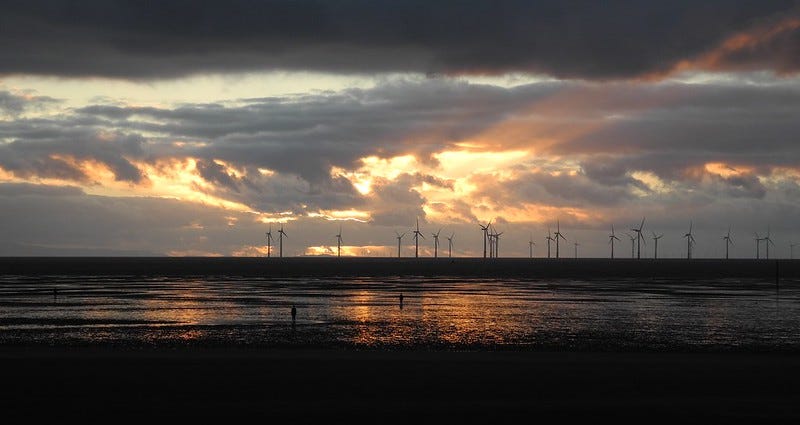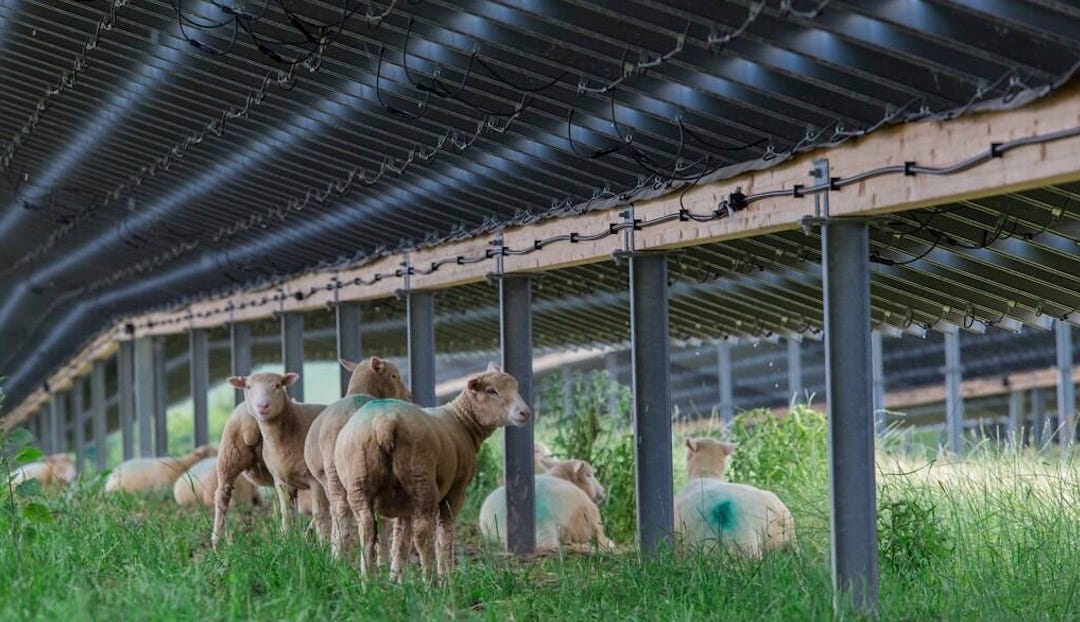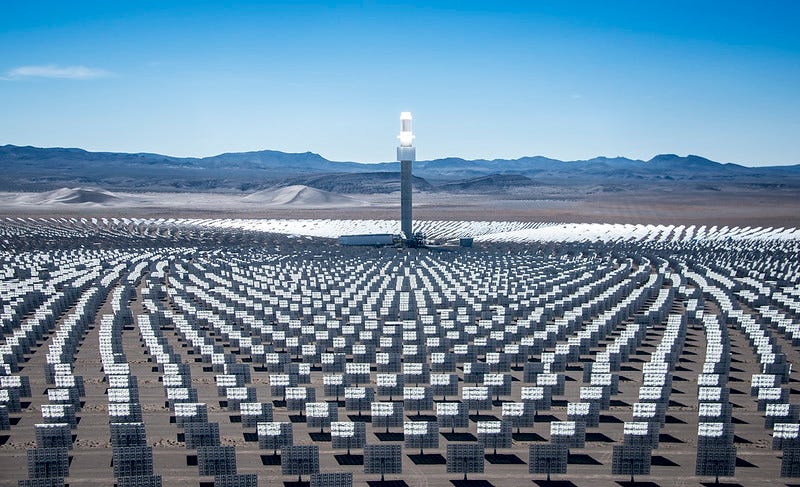Biden's 'big statement,' fracking with Covid funds; and Betterment's new offerings
Welcome to Callaway Climate Insights. Eight days until the election. Please share this with your friends and colleagues.

Last month, oil supermajor BP got into the offshore wind market, paying $1 billion to Equinor for wind farm assets. Photo: Matthew Smith/flickr.
Thirty years from now, as our children and their children look back from 2050 to the beginnings of the global battle to mitigate climate change here and now, they’ll wonder how a politician saying the world needs to transition from oil to renewable energy could possibly be controversial.
Sen. Joe Biden could not have said it any more clearly in the presidential debate last week, and yet you would think some voters were hearing it for the first time. President Trump jumped all over him with “that’s a big statement” and the political press duly turned it into a highlight in an otherwise boring debate. The idea that the transition, according to Biden’s own climate platform, will create far more jobs in renewable energy than it will cost in the oil industry, was lost in the ensuing hubbub.
The statement will have little impact, at this stage, on voting patterns ahead of next week’s election. But it stood out in the debate, perhaps because it was true. The transition has already begun, with or without Biden’s support. In other countries, it’s moving even faster. Japan this week joined China, Germany, and Eastern Europe as it pledged to move away from its reliance on coal production and into renewables over the next decade.
Many leading oil companies, including BP, Eni, Total, and Royal Dutch Shell, have announced plans to start transitioning to renewable energy. One of the industry’s lobbying groups has even built an ESG center for helping its clients transition. The cards are on the table for the biggest transition the world has seen since the Industrial Revolution. It was nice to see Biden acknowledge the game has started, even if some were more surprised than others.
More insights below. . . .
And don’t forget to contact me directly if you have suggestions or ideas at dcallaway@callawayclimateinsights.com.
Betterment unveils new socially responsible investment offerings
. . . . Exclusively for Callaway Climate Insights, Robert Powell interviews Boris Khentov, senior vice president of operations and legal counsel at Betterment, which recently announced new Socially Responsible Investment (SRI) portfolio offerings, including the Social Impact and Climate Impact funds. . . .
Animal Farm as hedge fund turns on ESG asset managers

. . . . Barnyard bravado: Hedge funds love to bait each other almost as much as they love being first to a trade. A prominent British hedge fund manager this week took a swing at some of the biggest financial managers in the world for their lack of action on the climate front of their portfolios. Calling companies like BlackRock and Vanguard “sheep” for not leading on climate shareholder resolutions, Christopher Hohn, founder of The Children’s Investment Fund, argued that it’s not enough to support resolutions from environmental groups at the annual meetings of companies they hold. In letters to seven of the largest managers, Hohn said the managers need to lead by demanding climate disclosures and practice changes at the holdings themselves. Too soon to tell if Hohn hit a nerve, but stay tuned. The larger these money managers grow, the more thin-skinned they become. . . .
. . . . Under the outback sun: In one of the more dramatic solar initiatives I’ve seen to date, Australia and Singapore are reportedly planning the world’s largest solar installation in the Australian outback. It will be connected by the longest cable for 3,7000 kilometers across Indonesian waters to Singapore, where ultimately it will provide energy for about 20% of the island nation. The Australian-ASEAN Power Link project will also need the world’s largest battery to power the solar energy through the cable. But the most interesting part of it is that the participants expect the 10-Gigawatt project (about 20,000 football fields of panels) is expected to come on line in 2026. Now that’s thinking big! . . .
. . . . Paris or bust: Japan’s pledge this week to join a growing list of nations to pledge to reach carbon neutrality by 2050 was seen as a major step forward by the Paris Agreement crowd, as it put the world’s third largest economy on a strict time table to end its historical reliance on coal power. Prime Minister Yoshihide Suga overrode years of Japanese government intransigence on climate change, often attributed to cost, and said it would work to show major improvement by 2030. To do so, Japan will need to revise its current energy plans to dramatically scale back coal power, including the financing of coal projects in other countries. Japan is the fifth largest emitter of greenhouse gases and the sixth in terms of coal usage, behind Russia and ahead of South Africa. China is by far the biggest user of coal power. See the ranking of coal consumption by country here. In some ways, Japan is just following the market, as the shift away from coal makes financing these projects more expensive, but other countries look at this and feed on it. Japan’s pledge follows a similar pledge by China just a few weeks ago, and Poland before that. . . .
. . . . Parsing propaganda: Jack Hamilton, author, journalism professor, and longtime colleague on the board of the International Center for Journalists, is out with a new book just before the election, titled Manipulating the Masses: Woodrow Wilson and the Birth of American Propaganda. Jack previewed the book here on Callaway Climate Insights back in May, writing a column about our current government’s handling of the Covid-19 pandemic and why transparency is so important. Five months later, it’s even more important. . . .
. . . . SPAC alert: Shares of Lordstown Motors (RIDE), which went public Monday through a special purpose acquisition vehicle, continued to fall Tuesday after an initial pop of about 20%. The shares were last trading at about $17, after trading as high as $21.75. Lordstown raised $675 million in the offering and will use the funds to begin buildings its line of Endurance electric pickup trucks. The company said it has preorders for about 40,000 trucks, and production will begin in the second half of 2021. . . .
. . . . Electric truckin’: The great and the good of the sustainability world are convening on Zoom this week for Greenbiz’s annual event, TheVerge. To kick-start the festivities, the media group published a list of the 25 most sustainable fleets on its website this morning, and it makes for good reading. The list includes a couple of power companies, a handful of progressive municipalities, and at least one beer company. . . .
Above, sheep may safely graze in the shade of solar panels at the Wadebridge solar farm. Photo: Belectric UK.
Data driven: Brrrr.

Above, sunrise in the Tetons. Photo: Esther Lee/flickr.
. . . . The National Weather Service says the coldest spot in the contiguous United States was -14°F. at Laramie, Wyo. on Tuesday. At the opposite end of the temperature gauge, the high on Monday was 104°F. at Rio Grande Village, Texas. . . .
News briefs: Growth in wind power in Japan and China
Watch this: Chinese scientists cover melting glacier with quilts to slow loss linked to climate change
Chinese scientists have reported success with the country’s first experiment with covering a glacier to slow the pace of its melting. Researchers from the Chinese Academy of Sciences covered 5,380 square feet off the Dagu Glacier on the Tibetan Plateau in early August 2020. Two months later, the covered areas were found to be one meter thicker than parts directly exposed to the sun.
Editor’s picks:
Asia’s wind business, by land and by sea
Demand for cooling is a blind spot for sustainable development
North Dakota sends Covid funds to other business, including fracking
Latest findings: New research, studies and projects

Above, Nevada Crescent Dunes solar installation. Photo: Bureau of Land Management.
Time to electrify everything?
An aggressive push toward 100% renewable energy could save Americans as much as $321 billion in energy costs, while also slashing greenhouse gas emissions, new research analysis says. According to a recent report in The Guardian citing an analysis from energy policy group Rewiring America, U.S. households would benefit financially from a complete switch to clean energy sources such as solar and wind. More than 40% of energy emissions are determined by appliances in and around the home, according to the report, such as heating, electricity, refrigeration and car use. It’s possible, the group asserts, that the transition could create millions of new jobs, save each household on average between $1,050 to $2,585 per year on its energy bills, and reduce greenhouse gas emissions. Experts say such an effort would face challenges, including ramping up solar throughout the U.S. and overcoming issues in the supply chain.
More research:

